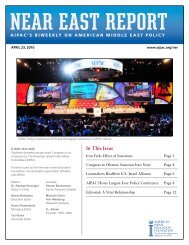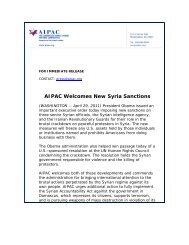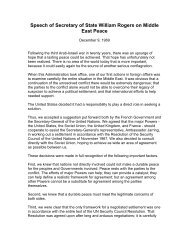2013 Briefing Book - Print Version - Aipac
2013 Briefing Book - Print Version - Aipac
2013 Briefing Book - Print Version - Aipac
You also want an ePaper? Increase the reach of your titles
YUMPU automatically turns print PDFs into web optimized ePapers that Google loves.
ISRAEL AT RISK<br />
Ballistic missiles are one of the most effective means of delivering a nuclear payload. They do not<br />
encounter the difficulties of long-range aircraft flight or the uncertainties of smuggling via terrorist<br />
proxies. Thus, for Tehran, missiles that carry unconventional weapons provide the best means to<br />
strike or intimidate its enemies.<br />
The International Atomic Energy Agency (IAEA) has revealed conclusive evidence that Iran has<br />
been developing the technology to place a bomb onto a ballistic missile. According to the IAEA,<br />
Iran has tried to adapt its main long-range missile to carry a nuclear payload. Documents reveal<br />
that Iran has worked on the “redesign of the inner cone of the Shihab‐3 missile reentry vehicle to<br />
accommodate a nuclear warhead.”<br />
Hamas, Hizballah Acquire Sophisticated Weapons<br />
Both of the principal terrorist organizations based along Israel’s borders—Hamas and Hizballah—<br />
continue to build up their stockpiles of weapons and strengthen their military capabilities. These<br />
groups receive assistance from Iran to expand their arsenals and to carry out attacks against Israel.<br />
Since Israel withdrew from Gaza in 2005, Hamas has launched more than 9,500 rockets at<br />
Israel, including 1,600 during a major barrage in November 2012. Hamas continues to expand<br />
the range and lethality of its arsenal, which includes 122mm Grad rockets and 120mm mortar<br />
bombs imported from Iran. New 240mm Fajr heavy rockets have now also entered the arena<br />
and have already been used to bombard heavily populated central Israel. One of the unintended<br />
consequences of Libya’s liberation and Hosni Mubarak’s downfall in 2011 has been a flood of<br />
shoulder-launched anti-aircraft missiles and other terror weapons passing from Qaddafi’s arsenal<br />
through the Sinai Peninsula into Gaza.<br />
Hizballah—also a U.S.-designated terrorist group—has accumulated 60,000 rockets, including<br />
both short- and long-range versions, all aimed at Israel. According to former Secretary of Defense<br />
Robert Gates and other U.S. officials, Hizballah possesses more advanced weaponry than most<br />
countries. A New York Times article published after WikiLeaks released thousands of State<br />
Department cables cites Syria’s transfer of 10 Scud-D ballistic missiles to Hizballah that can<br />
target all of Israel. This acquisition of advanced technology, which may soon accelerate if Syria’s<br />
Assad seeks to secure parts of his own arms stockpile from rebels, demonstrates that Hizballah<br />
is a regional threat—to Israel, other U.S. allies and areas of U.S. interest. The radical Shia Islamic<br />
group also threatens the stability and sovereignty of Lebanon.<br />
79








